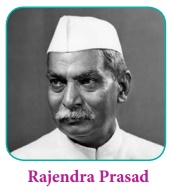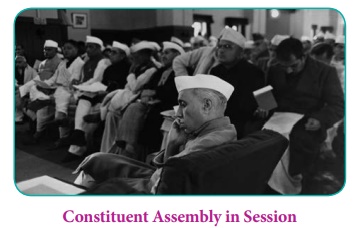Reconstruction of Post-colonial India | History - Making of the Constitution | 12th History : Chapter 8 : Reconstruction of Post-colonial India
Chapter: 12th History : Chapter 8 : Reconstruction of Post-colonial India
Making of the Constitution
Making of the Constitution
It was a
demand from the Indian National Congress, voiced formally in 1934, that the
Indian people shall draft their constitution rather than the British
Parliament. The Congress thus rejected the White Paper circulated by the
colonial government. The founding principle that Indians shall make their own
constitution was laid down by Gandhi as early as in 1922. Gandhi had held that
rather than a gift of the British Parliament, swaraj must spring from ŌĆśthe
wishes of the people of India as expressed through their freely chosen
representativesŌĆÖ.
Elections
were held, based on the 1935 Act, to the Provincial Assemblies in August 1946.
These elected assemblies in turn were to elect the Central Assembly, which
would also become the Constituent Assembly. The voters in the July 1946
elections to the provinces were
those who
owned property ŌĆō the principle of universal adult franchise was still a far
cry. The results revealed the Muslim LeagueŌĆÖs command in Muslim majority
constituencies while the Indian National Congress swept the elections
elsewhere. The League decided to stay away from the Constitution making process
and pressed hard for a separate nation. The Congress went for the Constituent
assembly.
The
elected members of the various Provincial assemblies voted nominees of the
Congress to the Constituent Assembly. The Constituent Assembly (224 seats) that
came into being, though dominated by the Congress, also included smaller
outfits such as the communists, socialists and others. The Congress ensured the
election of Dr B.R. Ambedkar from a seat in Bombay and subsequently elected him
chairman of the drafting committee. Apart from electing its own stalwarts to
the Assembly, the Congress leadership made it a point to send leading
constitutional lawyers.
This was
to make a constitution that contained the idealism that marked the freedom
struggle and the meaning of swaraj, as specified in the Fundamental Rights
Resolution passed by the Indian National Congress at its Karachi session (March
1931). This, indeed, laid the basis for the making of our constitution a
document conveying an article of faith guaranteeing to the citizens a set of
fundamental rights as much as a set of directive principles of state policy.
The constitution also committed the nation to the principle of universal adult
franchise, and an autonomous election commission. The constitution also
underscored the independence of the judiciary as much as it laid down sovereign
law-making powers with the representatives of the people.
The
members of the constituent assembly were not averse to learn and pick up
features from the constitutions from all over the world; and at the same time
they were clear that the exercise was not about copying provisions from the
various constitutions from across the world.
Jawaharlal
Nehru set the ball rolling, on December 13, 1946, by placing the Objectives
Resolution before the Constituent Assembly. The assembly was convened for the
first time, on December 9, 1946. Rajendra Prasad was elected chairman of the
House. The Objectives Resolution is indeed the most concise introduction to the
spirit and the contents

The
Objectives Resolution is indeed the most concise introduction to the spirit and
the contents of the Constitution of India. The importance of this resolution
can be understood if we see the Preamble to the Constitution and the
Fundamental Rights and Directive Principles of State Policy enshrined in it and
as adopted on November 26, 1949.

The
Constitution of India, thus, marked a new beginning and yet established
continuity with IndiaŌĆÖs past. The Fundamental Rights drew everything from
clause 5 of the Objectives Resolution as much as from the rights enlisted by
the Indian National Congress at its Karachi session (discussed in Lesson 5).
The spirit of the Constitution was drawn from the experience of the struggle
for freedom and the legal language from the Objectives Resolution and most
importantly from the Universal Declaration of Human Rights (UDHR), promulgated
by the United Nations on December 10, 1948.
Related Topics